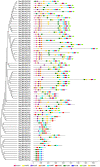Genome-Wide Analysis of the LRR-RLP Gene Family in a Wild Banana (Musa acuminata ssp. malaccensis) Uncovers Multiple Fusarium Wilt Resistance Gene Candidates
- PMID: 35456444
- PMCID: PMC9025879
- DOI: 10.3390/genes13040638
Genome-Wide Analysis of the LRR-RLP Gene Family in a Wild Banana (Musa acuminata ssp. malaccensis) Uncovers Multiple Fusarium Wilt Resistance Gene Candidates
Abstract
Banana is the most popular fruit in the world, with a relevant role in food security for more than 400 million people. However, fungal diseases cause substantial losses every year. A better understanding of the banana immune system should facilitate the development of new disease-resistant cultivars. In this study, we performed a genome-wide analysis of the leucine-rich repeat receptor-like protein (LRR-RLP) disease resistance gene family in a wild banana. We identified 78 LRR-RLP genes in the banana genome. Remarkably, seven MaLRR-RLPs formed a gene cluster in the distal part of chromosome 10, where resistance to Fusarium wilt caused by Foc race 1 has been previously mapped. Hence, we proposed these seven MaLRR-RLPs as resistance gene candidates (RGCs) for Fusarium wilt. We also identified seven other banana RGCs based on their close phylogenetic relationships with known LRR-RLP proteins. Moreover, phylogenetic analysis of the banana, rice, and Arabidopsis LRR-RLP families revealed five major phylogenetic clades shared by these plant species. Finally, transcriptomic analysis of the MaLRR-RLP gene family in plants treated with Foc race 1 or Foc TR4 showed the expression of several members of this family, and some of them were upregulated in response to these Foc races. Our study provides novel insights into the structure, distribution, evolution, and expression of the LRR-RLP gene family in bananas as well as valuable RGCs that will facilitate the identification of disease resistance genes for the genetic improvement of this crop.
Keywords: Fusarium wilt; LRR-RLP; banana; disease resistance; genetic improvement; genome-wide analysis.
Conflict of interest statement
The authors declare no conflict of interest.
Figures







References
-
- FAO Global Programme on Banana Fusarium Wilt Disease. 2017. [(accessed on 21 February 2022)]. Available online: https://www.fao.org/publications/card/en/c/29d4ef48-7454-4f98-8260-e5f19....
-
- Arango Isaza R.E., Diaz-Trujillo C., Dhillon B., Aerts A., Carlier J., Crane C.F., de Jong T.V., de Vries I., Dietrich R., Farmer A.D., et al. Combating a global threat to a clonal crop: Banana black Sigatoka pathogen Pseudocercospora fijiensis (synonym Mycosphaerella fijiensis) genomes reveal clues for disease control. PLoS Genet. 2016;12:e1005876. doi: 10.1371/journal.pgen.1005876. - DOI - PMC - PubMed
-
- Maryani N., Lombard L., Poerba Y.S., Subandiyah S., Crous P.W., Kema G.H.J. Phylogeny and genetic diversity of the banana Fusarium wilt pathogen Fusarium oxysporum f. sp. cubense in the Indonesian centre of origin. Stud. Mycol. 2019;92:155–194. doi: 10.1016/j.simyco.2018.06.003. - DOI - PMC - PubMed
Publication types
MeSH terms
LinkOut - more resources
Full Text Sources

